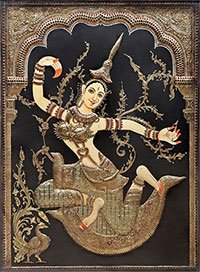Ghurghura, Ghurghurā: 8 definitions
Introduction:
Ghurghura means something in Buddhism, Pali, Hinduism, Sanskrit. If you want to know the exact meaning, history, etymology or English translation of this term then check out the descriptions on this page. Add your comment or reference to a book if you want to contribute to this summary article.
In Hinduism
Sports, Arts and Entertainment (wordly enjoyments)
Source: archive.org: Syainika Sastra of Rudradeva with English Translation (art)Ghurghura (घुर्घुर) refers to “producing terrible sounds” [?], according to the Śyainika-śāstra: a Sanskrit treatise dealing with the divisions and benefits of Hunting and Hawking, written by Rājā Rudradeva (or Candradeva) in possibly the 13th century.—Accordingly, “Hunting by packs of dogs is that in which dogs are let loose at hares and other animals in arid tracts. [...] The hares scream loudly (ghurghura-uddāma-rāviṇī) and the dogs pursue them; and in a short time there is a great fight tooth and nail. This produces a feeling of the terrible. [...]”.

This section covers the skills and profiencies of the Kalas (“performing arts”) and Shastras (“sciences”) involving ancient Indian traditions of sports, games, arts, entertainment, love-making and other means of wordly enjoyments. Traditionally these topics were dealt with in Sanskrit treatises explaing the philosophy and the justification of enjoying the pleasures of the senses.
In Buddhism
Tibetan Buddhism (Vajrayana or tantric Buddhism)
Source: academia.edu: The Structure and Meanings of the Heruka Maṇḍala1) Ghurghurā (घुर्घुरा) or Ghurghurāmālā refers to a “wreath of jingle bells” and represents one of the items held in the left hand of Heruka: one of the main deities of the Herukamaṇḍala described in the 10th century Ḍākārṇava chapter 15. Heruka is positioned in the Lotus (padma) at the center; He is the origin of all heroes; He has 17 faces (with three eyes on each) and 76 arms [holding, for example, ghurghurā-mālā]; He is half black and half green in color; He is dancing on a flaming sun placed on Bhairava and Kālarātrī.
2) Ghurghura (घुर्घुर) is the name of a Vīra (hero) who, together with the Ḍākinī named Ghurghurī forms one of the 36 pairs situated in the Ākāśacakra, according to the same work. Accordingly, the ākāśacakra refers to one of the three divisions of the dharma-puṭa (‘dharma layer’), situated in the Herukamaṇḍala. The 36 pairs of Ḍākinīs and Vīras [viz., Ghurghura] are dark blue in color; they each have one face and four arms; they hold a skull bowl, a skull staff, a small drum, and a knife.

Tibetan Buddhism includes schools such as Nyingma, Kadampa, Kagyu and Gelug. Their primary canon of literature is divided in two broad categories: The Kangyur, which consists of Buddha’s words, and the Tengyur, which includes commentaries from various sources. Esotericism and tantra techniques (vajrayāna) are collected indepently.
Languages of India and abroad
Sanskrit dictionary
Source: DDSA: The practical Sanskrit-English dictionaryGhurghura (घुर्घुर).—
1) Guinea-worm.
2) Snorting, growling, grumbling.
-rā Growling &c. (as a dog).
Derivable forms: ghurghuraḥ (घुर्घुरः).
Source: Cologne Digital Sanskrit Dictionaries: Shabda-Sagara Sanskrit-English DictionaryGhurghura (घुर्घुर).—m.
(-raḥ) A kind of worm borrowing in the skin, guinea worm, Dracunculus. f. (-rī) The mole cricket. f.
(-rā) Growling, as of dog or cat. E. ghur imitative sound, and ghur to sound, with ka aff.
Source: Cologne Digital Sanskrit Dictionaries: Monier-Williams Sanskrit-English Dictionary1) Ghurghura (घुर्घुर):—[from ghur] m. a kind of worm burrowing in the skin (Dracunculus), [cf. Lexicographers, esp. such as amarasiṃha, halāyudha, hemacandra, etc.]
2) Ghurghurā (घुर्घुरा):—[from ghurghura > ghur] f. growling (of a dog or cat), [Horace H. Wilson]
Source: Cologne Digital Sanskrit Dictionaries: Yates Sanskrit-English DictionaryGhurghura (घुर्घुर):—(raḥ) 1. 3. m. A kind of worm, dracunculus. (rī) f. The molecricket. (rā) growling.
[Sanskrit to German]
Sanskrit, also spelled संस्कृतम् (saṃskṛtam), is an ancient language of India commonly seen as the grandmother of the Indo-European language family (even English!). Closely allied with Prakrit and Pali, Sanskrit is more exhaustive in both grammar and terms and has the most extensive collection of literature in the world, greatly surpassing its sister-languages Greek and Latin.
See also (Relevant definitions)
Starts with: Ghurghuraka, Ghurghuramala, Ghurghurana, Ghurghurata, Ghurghuray, Ghurghuraya, Ghurghurayate.
Full-text: Gharghurgha, Ghurghuri, Ghurghurata, Parighargharam, Parighurgharam, Uddama, Ravi, Ravini, Akashacakra.
Relevant text
Search found 4 books and stories containing Ghurghura, Ghurghurā; (plurals include: Ghurghuras, Ghurghurās). You can also click to the full overview containing English textual excerpts. Below are direct links for the most relevant articles:
Garga Samhita (English) (by Danavir Goswami)
Verse 3.10.7 < [Chapter 10 - The Glory of Śrī Girirāja]
The Skanda Purana (by G. V. Tagare)
Chapter 23 - Lohāsura Devastates Dharmāraṇya < [Section 2 - Dharmāraṇya-khaṇḍa]
Chapter 42 - The Story of Brāhmaṇa Aitareya < [Section 2 - Kaumārikā-khaṇḍa]
The Devi Bhagavata Purana (by Swami Vijñanananda)
Yoga Vasistha [English], Volume 1-4 (by Vihari-Lala Mitra)
Chapter XLVIII - Description of daivastras or supernatural weapons < [Book III - Utpatti khanda (utpatti khanda)]